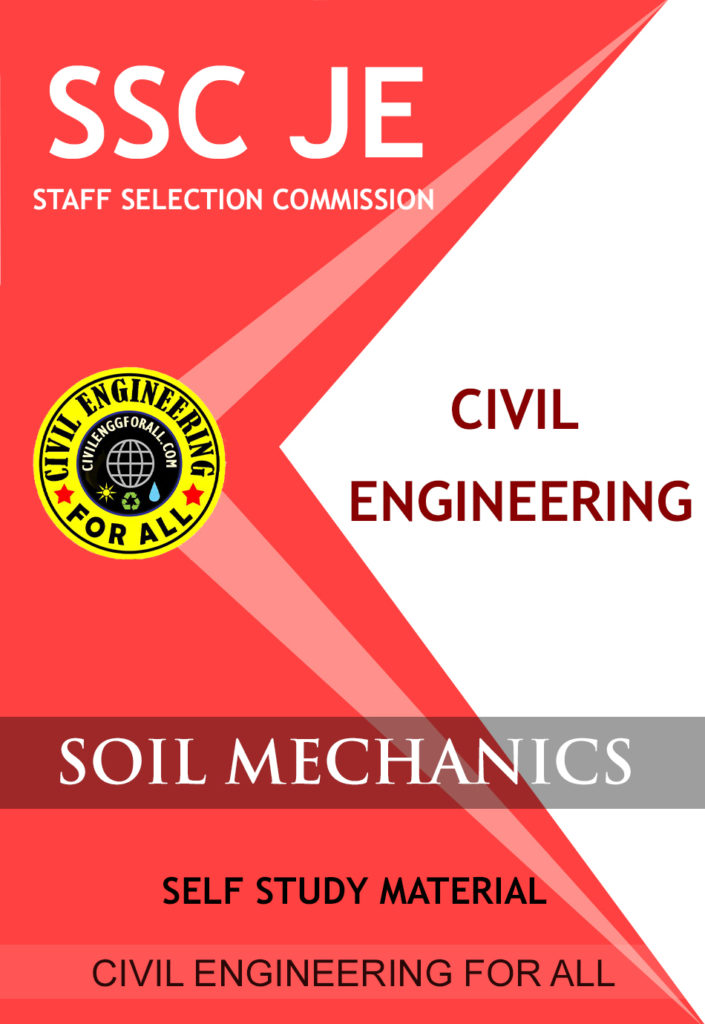

CONTENTS
- Soil Classification
- Earth Pressure
- Rankine’s Theory of Passive Earth Pressure
- Effective Stress Principle
- Pore Water Pressure Parameters
- Stress Distribution in Soils
- Shear Strength

SOIL CLASSIFICATION
In engineering terms, soil is generally softer, weaker and more weathered material overlying rock. All soils consist of solid particles assembled in a relatively loose packing. The voids between the particles may be filled completely with water (fully saturated soils) or may be partly filled with water and partly with air (partly saturated soils).
IES MASTER CIVIL GATE STUDY MATERIALS : CLICK HERE
Formation of Soil
Soil is defined as a natural aggregate of mineral grains, with or without organic constituents, that can be separated by gentle mechanical means such as agitation in water. Whereas rock is considered to be a natural aggregate of mineral grains connected by strong and permanent cohesive forces. Weathering of the rock decreases the cohesive forces binding the material grains and leads to the disintegration of bigger masses to smaller particles. Soils are formed by the process of weathering of the parent rock. The weathering of the rocks might be mechanical (disintegration) and/or chemical (decomposition). The disintegrated or weathered material may either be found deposited at its own place of origin, or may get transported by agents like water, wind, ice, etc., before deposition. Moreover depending upon whether the sediments are transported by water, ice or wind, the soils are called as alluvial, glacial, or aeolin, respectively.
Three stages involved in the formation of transported soils are:
- Weathering
- Transportation
- Deposition of weathered material
Types of Soils: On the basis of origin, types of soils are
- Residual Soil: A soil that is formed by weathering of the parent rock and still occupies the position of the rock from which it has been formed, is called a residual soil.
- Transported Soil: Any soil that has been transported from its place of origin by wind, water, ice or some other agency, and has been re-deposited, is called a transported soil. Transported soils are classified as follows: (a) Alluvial deposits (b) Lacustrine deposits (c) Marine deposits (d) Aeolin deposits; and (e) Glacial deposits


Shear Strength of Soil. It is the resistance to deformation by continuous shear displacement of soil particles on masses upon the action of a shear stress. The failure conditions for a soil may be expressed in terms of limiting shear stress, called shear strength or as a function of the principal stresses. The shearing resistance of a soil is constituted basically of the following compounds:
- The structural resistance to displacement of the soil because of the interlocking of the particles.
- The frictional resistance to translocation between the individual soil particles at their contact point, and
- Cohesion or adhesion between the surfaces of the soil particles. The shear strength in cohesionless soil results from intergranular friction alone, while in all other soils it results both from internal friction as well as cohesion.
BEARING CAPACITY
The lower part of a structure that transmits the load, of the superstructure and also its own weight to the soil or rock, is called foundation.
ACE CIVIL ENGINEERING GATE STUDY MATERIALS : CLICK HERE
Types of Foundations
1. Footings
The direct load bearing structure which is constructed as a spread under the base of a wall is called a footing.
2. Combined footing
The combination of two or more footings joined together to form a small mat, is called a combined footing.
3. Strip foundations
The foundation whose length is considerably greater than its width is called a strip or continuous foundation.
4. Raft foundations
The foundation which supports a large number of footing of loads of a single unit and covers the whole loaded area is called a raft foundation.
5. Pile foundation
The foundation which is provided in soils incapable to transmit the structural load to suitable stratum by inserting relatively slender structural elements called piles, is known as pile foundation. The pile foundation may be classified as under:
- End bearing piles. The piles which act as column and transmit the load through weak soil to a firm stratum at a greater depth, are called end bearing piles.
- Friction piles. The piles which carry the structural load by the friction between the surfaces of the piles and the surrounding soil, are called friction piles.
- Compaction piles. The friction piles which are driven into cohesionless soil for increasing the shear strength of the soils by compaction, are called compaction piles.
MADE EASY GEOTECHNICAL ENGINEERING GATE NOTES : CLICK HERE
Shallow and Deep Foundations
The foundation whose depth is not more than its width, is called a shallow foundation. The foundation whose depth is many times more than its width, is called a deep foundation.
Bearing Capacity of soil
The load or pressure developed under the foundation without introducing any damaging movement in foundation and in the supported structure, is called bearing capacity of the soil.
SEEPAGE
Percolation of water through the soil pores under an energy gradient is known as seepage. The pressure exerted on the soil due to seepage of water is known as seepage force or seepage pressure. Seepage problem occurs in all earthen dams, retaining walls and foundations on permeable soil.
Flow Nets
The flow of water through a soil can be represented graphically by a flow net, a form of curvilinear net made up of a set of flow line intersected by a set of equipotential lines.
Flow Lines
The paths which water particle follow in the course of seepage are known as flow lines. Water flows from points of high head to points of low head, and makes smooth curves, representing the paths followed by moving water particles.
Equipotential Lines
As the water moves along the flow it experiences a continuous loss of head. If we can obtain the head causing flow at points along a flow line, then by joining up points of equal potential we obtain a second set of line known as equipotential lines.
Hydraulic Gradient
The potential drop between two adjacent equipotential lines divided by the distance between them is known as the hydraulic gradient. It attains a maximum along a path normal to the equipotentials and in isotropic soil the flow follows the path of the steepest gradients, so that flow lines cross equipotential lines at right angles. Flow Path. The space between adjacent flow lines is called flow path or flow channel.
GEOTECHNICAL ENGINEERING ACE GATE NOTES : CLICK HERE
Piezometric Level
At all points along an equipotential line, the water would rise in a piezometric tube to a certain elevation known as piezometric level.
Two dimensional flow
To determine quantity of water flowing through saturated soil mass and the distribution of water pressure by the theory of flow of fluid through porous medium the following assumptions were made.
- Soil mass is homogeneous and isotropic.
- The soil and water are incompressible.
- The flow is assumed to be laminar so that Darcy’s law is valid.
- Quantity of water stored in soil pores is constant so that steady flow conditions have been established.
SOIL MECHANICS STUDY MATERIAL FOR SSC JE PDF CIVILENGGFORALL
DOWNLOAD LINK : CLICK HERE
PASSWORD : CivilEnggForAll
\
OTHER USEFUL BOOKS
- BUILDING MATERIALS – MOCK TEST 1 (QUICK)
- TELANGANA STATE PUBLIC SERVICE COMMISSION – ASSISTANT ENGINEER 2023 – TSPSC AE 2023 CIVIL ENGINEERING EXAM SOLVED PAPER WITH EXPLANATIONS PDF FREE DOWNLOAD
- SSC JE 2023 CIVIL ENGINEERING (CPWD/CWC/MES) EXAM SOLVED PAPER PDF FREE DOWNLOAD
- BIHAR PUBLIC SERVICE COMMISSION ASSISTANT ENGINEER (BPSC AE) 2022 CIVIL ENGINEERING EXAM SOLVED PAPER WITH EXPLANATIONS PDF
- NHPC (NATIONAL HYDROELECTIC POWER CORPORATION) JUNIOR ENGINEER NHPC JE 2022 CIVIL ENGINEERING EXAM SOLVED PAPER PDF FREE DOWNLOAD

Leave a Reply